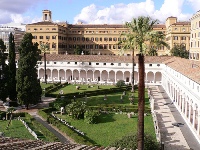Museo Nazionale Romano, RomeMuseo Nazionale Romano, RomeThe National Museum of Rome is a set of museums in Rome, Italy, split between various branches across the city. It was founded in 1889 and inaugurated in 1890, during the Risorgimento, with the aim of collecting antiquities from between the 5th century BC to the 3rd century AD. The building was constructed in the neo-cinquecentesco style between 1883 and 1887 by architect, Camillo Pistrucci to house a Jesuit seminary. It was initially used as a military hospital during the Second World War, but later it was acquired by the state. The museum accommodates the sculpture, coins and jewelry collections. Its first collection was formed from the archeological collections of the Museo Kircheriano and the numerous new discoveries in Rome after it became new capital of the new Kingdom of Italy. The notable attractions are the sculptures of the period between the late Republic and the early imperial period as well as from the baroque periods. The museums archeological collection is not only the best in Rome but also well acclaimed worldwide. The most striking statue is that of Galate committing suicide with his sword after killing his wife to avoid her falling in hands of the enemy. The statue of Aphrodite on the temple on the Greek island Cnidos is an eye-catcher. The Museum's numismatic collections include great currency in Italy. Most of the coins on display in the collections are very rare like Theodoricís medallion, the four ducats of Paul II with the navicella of St Peter, and the silver piastre of the Pontifical State with views of the city of Rome. The most famous inscriptions are housed in the first room. There is a sixth-century BCE monument that was discovered below the Lapis Niger, and the Lapis Satricanus, an equally ancient inscription mentioning Valerius Publicola along with an old dedication to Castor and Pollux. In addition, there are finds from the Tiber related to the cult of Asclepius, the statues from Ariccia, and the inscription that was recently discovered near the Meta Sudans. On the third floor, you will find the inscriptions from ancient Judaism, Mithraism, and Christianity. Museo Nazionale Romano remains open from Tuesday to Sunday from 9:00 am to 7.45 pm, except on Mondays. 
|